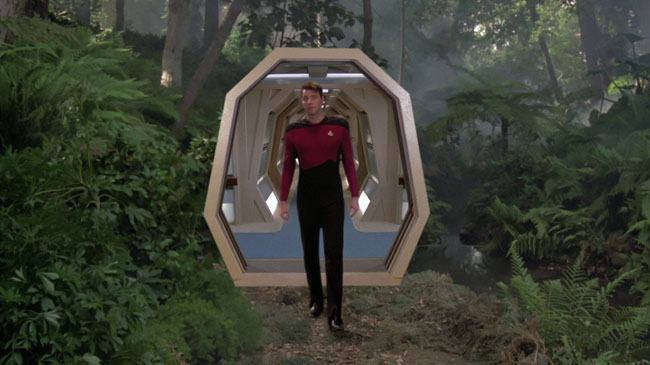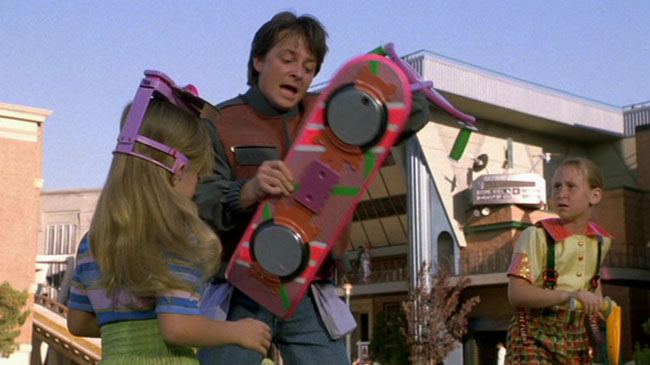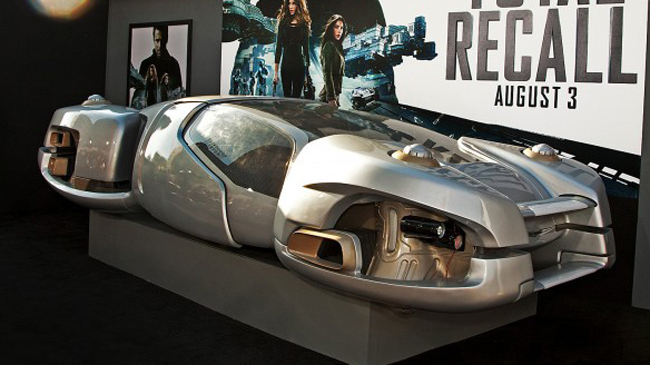Movie Sci-Fi Technology: Could It Ever Happen?
Scientists weigh in on classic movie sci-fi tech...

Mind Wiping Devices (Men in Black)
To celebrate National Science and Engineering Week, which runs from the 15 to 24 March 2013, a host of proper real-life scientists took the time to speak to us about the chances of some of sci-fi cinema's most classic gadgets becoming a reality. First up, Men In Black 's Neuralyzer....
The kit: The Neuralyzer is a key bit of kit for the Men in Black . About the size of a cigar, it gives a bright flash which destroys the memories of the past hours, days, weeks, months or years, depending on the chosen settings. Which could be really useful when you wake up after a few too many drinks to find you've insulted/spraypainted/abused your partner/parents/boss.
What are the chances? Neil Levy, Deputy Director (Research) of the Oxford Centre for Neuroethics, University of Oxford: “So far as I can tell, the technology is not at all realistic, in the near to midterm future, given its scope. We don’t have the technology to target specific memories without devastating other areas of the brain. With certain drugs however, such as Propofol, we can already effectively delete very recent memories, so if events are really recent then this form of drug treatment acts much like the Neuralyzer from Men In Black .”

Dream Invasion (Inception)
The kit: The 2010 Oscar-winning blockbuster Inception featured Leonardo DiCaprio as Dom Cobb, a thief who commits corporate espionage by infiltrating the subconscious of his targets. It’s not the first time that science fiction has centred on removing or implanting ideas or memories through dreams (see Total Recall or Eternal Sunshine of the Spotless Mind ), but could this ever happen in real life?
What are the chances? Prof Jan Schnupp, Dept. of Physiology, Anatomy and Genetics, University of Oxford UK: “All mental activity, including dreams, is the product of the activity of billions of neurons in our heads. The main obstacle is how we intercept enough of the signals to get a clear picture of what is going on in a dream. With current technology, implanting microelectrodes into the brain is the only way to read this activity with sufficient detail – but you would quite possibly need thousands of them, which means drilling numerous holes in your head. The ethical and legal hurdles would make this extremely difficult. At present, there are no less invasive technologies on the horizon, so for the foreseeable future your dreams are safe from prying eyes.”

Forcefields (The Hunger Games)
The kit: Forcefields are a fairly common occurrence in science fiction, most recently used in The Hunger Games to prevent contestants escaping from the games. The invisible force field gave anyone who touched it a shock and prevented them from leaving the arena.
What are the chances? Dr Ruth Bamford at STFC (Space Plasmas Group): “The experiments and theoretical work are looking very promising for this technology to become a reality. The idea is to deal with the mission critical threat of radiation in space. It has been stated by NASA that the radiation is the only technical "showstopper" for manned mission to Mars.
“We can now generate an artificial magnetic field and a plasma source - the question is what we could put on a spacecraft. In the past it was assumed that you needed a huge magnet on the spacecraft to be effective, but our work has shown that a plasma deflector shield held and controlled using an artificial magnetic field will work. As such the magnetic field needed is a fraction of that considered in the 1960s - we are trying to determine precisely how small.
“Dependent on funds and the will to pursue it, we could have force field technology on a flight demo in three to five years, and on a manned spacecraft in 10. It will open up the possibility for humanity to explore space.”

Insta-learning (The Matrix)
The kit: Author Malcolm Gladwell’s theory is that all successful people will have spent at least 10,000 hours practicing their skill, but who has time for that? What we want is to “plug into” The Matrix like Neo did, and become a martial arts expert overnight.
What are the chances? Dr Peter Földiák, School of Psychology and Neuroscience, St Andrews University, UK: “This is probably theoretically possible but there are huge scientific and technical problems that need to be solved before this can be done in practice. To "implant" knowledge directly into the brain, we would need a much better understanding of how information is stored in the brain by neurons, as well as precise mechanisms tapping into those neurons with new information. So while a lot of progress is being made in understanding how the brain works, the actual process of "knowledge implantation" is unfortunately a very distant dream.”

Holodecks (Star Trek)
The kit: Star Trek ’s holodeck is a simulated reality facility where objects and people are simulated by a combination of transported matter, replicated matter, tractor beams, and holograms, and sounds and smells are simulated by speakers and fragranced fluid atomizers. The feel of a large environment is simulated by suspending the participants on force fields which move with their feet, keeping them from reaching the walls of the room.
What are the chances? Could this be the future of gaming? Project Holodeck, from the University of Southern California, is making use of cutting edge technology to create immersive experiences that go beyond preconceptions, with a story and a challenge.
Mark Bolas, Director, Mixed Reality Lab at the Institute of Creative Technology, University of Southern California, USA: “If the goal is to make someone feel like their senses are immersed in an alternate world, then we do this every day at the Mixed Reality Lab by adapting technology that is already available. This involves using head-mounted displays that present the user with stereoscopic images. I expect pre-built consumer products to hit the market early next year. The technology is only half the magic; the other half is designing compelling virtual worlds. Projects such as Project Holodeck never fail to amaze me and I believe we will be seeing worlds that are very similar to current 3D games early next year, with maturation of the medium over the next few years. While we are already working on technology that projects images into the real world without the need for a head-mounted display, I feel this is further away.”

Hoverboards (Back To The Future)
The kit: We’ve wanted a hoverboard ever since we were kids and saw them in Back To The Future Part II and Part III , and it seems we’re not the only ones. Several companies and individuals have drawn on hovercraft technology to attempt to create hoverboard-like products but none have demonstrated similar experiences to those depicted in the movies... yet.
What are the chances? This year, Mattel, which was fictionally depicted as the manufacturer of the hoverboard in the Back To The Future series, announced it would be retailing a replica version of the hoverboard that would be able to "glide" instead of hovering.
Prof Phil Blythe, Chair of the Transport Policy Panel, The Institution of Engineering and Technology: “This technology is decades away, perhaps up to 20 years, but hopefully we will develop this as a stepping stone to flying cars.”

Self-driving Cars (Total Recall)
The kit: Fancy putting your feet up and reading a good book as you travel from A to B? Self-driving cars are a regular feature in science fiction films like Total Recall , and the opportunity to pick one up at your local garage forecourt is closer than you think. The Google Driverless Car project involves developing technology for driverless cars, with over 300,000 autonomous-driving miles being demonstrated accident free. Three US states have now passed laws permitting driverless cars.
What are the chances? David Evans, Chair of the Innovation Panel, The Institution of Engineering and Technology: “Self-driving cars have been demonstrated by the car manufacturers on their private test tracks already – so the issue is how long it will take for the technologies to become affordable and trusted by the public. My guess is that this may well happen over the next 10–20 years, since some cars have lots of the components in place already i.e. satellite navigation systems, cruise control and automatic parking.”

Jetpacks (Thunderball et al)
The kit: Jetpacks first appeared in science fiction in the 1920s and became popular in the 1960s, when Sean Connery’s Bond used one in the title sequence of Thunderball .
What are the chances? David Evans, Chair of the Innovation Panel, The Institution of Engineering and Technology: “It will be a very long time before we see a working and commercially available jet pack on the market, perhaps never. There are lots of big issues about the energy source used to power it, and then controlling stability in motion, not to mention safety, the environmental impact and the public acceptability in practice.”

Hypospray (Star Trek)
The kit: Featured in most of the Star Trek films, the hypospray is needleless and can be applied through clothing, rather than using a hypodermic needle to penetrate the skin.
What are the chances? Professor Ian Hunter, Department of Mechanical Engineering, Massachusetts Institute of Technology, USA: “We have recently developed a jet-injection system that injects medicine using a high-pressure jet, this can deliver specific amounts of medicine to variable depths beneath the skin without the need for a needle. This technology could solve many of the problems with existing drug delivery methods such as syringes, gas and spring injections, as well as being more precise. We are getting it commercialized as soon as possible and intend to develop an improved prototype very soon.”

The Batmobile (Batman Begins)
The kit: The car has gone through numerous incarnations, and as state-of-the-art technology has continued to advance, the vehicle has had to change to stay a step ahead of real-life advances. In The Dark Knight Rises , the Batmobile has become a tank-like armoured riot control vehicle, complete with machine guns, a cannon, and tank treads in place of tires. According to the man himself, the only thing that can penetrate its armour "isn't from this planet."
What are the chances? Prof Phil Blythe, Chair of the Transport Policy Panel, The Institution of Engineering and Technology: “The technology seen in the Batmobile is largely here already, there just currently isn’t a big enough market to go into production.”
The Total Film team are made up of the finest minds in all of film journalism. They are: Editor Jane Crowther, Deputy Editor Matt Maytum, Reviews Ed Matthew Leyland, News Editor Jordan Farley, and Online Editor Emily Murray. Expect exclusive news, reviews, features, and more from the team behind the smarter movie magazine.


